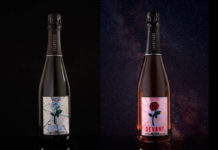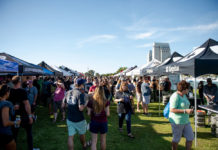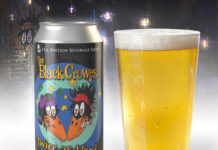Stop me if you’ve heard this one.
A guy walks into a bar, and the bartender asks him what he’ll have. The guy says, “Surprise me.” The bartender shrugs his shoulders, fills a glass half with beer, to which he adds a shot of gin, some lemon juice, garnishes and serves.
The guy looks at him and says, “Is this a joke?”
“No,” says the bartender. “It’s a beer cocktail, and that’ll be $8.”
Ok, so it wasn’t exactly a knee-slapper, but you get the point: Beer cocktails? Really?
Don’t dismiss the idea too soon. Beer cocktails are not as uncommon as one might think—the Black & Tan, the Shandy, the Chilada… Sound familiar?
There are people who firmly believe that beer should be served in only one of three ways – in a can, in a bottle, or out of the tap – and that by mixing or blending it with anything other than a handful of bar peanuts is utter sacrilege. However, even those who prefer to drink their beer unaltered choose particular styles or brands based on characteristics such as texture, density and most importantly, flavor. This is especially true with fans of craft beer, the specialty brews produced by small local breweries that offer a wide range of flavors, and that have really changed the way we look at and understand beer. Although the term ‘versatility’ may not come to mind when considering beer, the beverage does, in fact, wear many hats. This includes pairing it with food and employing it as a flavor foundation in various gastronomic ventures. Beer festivals and events are rapidly springing up all over the country, and 37 of the Brewers Association’s “Top 50 U.S. Breweries” were craft breweries, indicating that consumers are investing more interest into the multi-faceted nature of beer.
That being said, Merriam-Webster’s Dictionary defines ‘cocktail’ as “an iced drink of wine or distilled liquor mixed with flavoring ingredients; something resembling or suggesting such a drink as being a mixture of often diverse elements or ingredients.” Beer, especially craft beer, can absolutely constitute as a ‘diverse element or ingredient’ but, just as you would the ingredients in any good cocktail, the trick is to incorporate it as a single component in a simple, well-balanced recipe.
Although the concept of beer cocktails is not entirely foreign to American bars, it’s not generally what a customer walks up to the bar and orders. Without a high level of consumer interest, on-premise establishments are less likely to offer something that is not a guaranteed money maker. However, according to Stephen Beaumont, a freelance writer who specializes in beer, it’s a trend that is finding its way into bars in various forms as consumers and bartenders alike are developing increased interest in it.
“Beer cocktails are still very much on the fringe,” says Beaumont. “Even something as esoteric as molecular mixology is something more commonplace than beer cocktails. I’m not sure why there is such a reluctance to use beer in cocktails, but we’re definitely seeing some increased interest in it. The biggest trend is finding new blends, and many bars are including them on their menus.”
Beaumont first experienced the concept of beer cocktails in France some years ago, but found that they have had a lingering presence in alcohol beverage history. “I divide beer cocktails into three groups,” he says. “One is beer blends, when you take two or more different beers and blend them together, something like a black & tan, which is the most common. The second is when you add another element to the mix, whether it’s spirits, fruit juices or any combination thereof. The third type of beer cocktail is when beer is used as a flavoring ingredient in a traditionally-styled cocktail.”
Combining good beer with distilled spirits may not seem entirely appetizing, but when you consider some well-known and traditional beer cocktails, coming up with a menu of recipes for your venue is neither difficult nor delusional.

“With a little bit of beer knowledge you can learn to group beers by their flavor characteristics,” says Matt Brynildson, Brew Master at Firestone Walker Brewing Co., in Paso Robles, California, who is experimenting with and developing beer blends based on his experiences with them throughout out Belgium and Germany. “You’ve got your stouts with their chocolate and coffee sides, and then there are beers that are naturally less bitter and a little sweeter. So you can group beers under ‘bitter’, ‘sweet’ or ‘sour’, think about them as separate components and blend them with those characteristics in mind. Heffeweizen fits into the blending schematic well because it’s low in bitterness, has a full body and a unique clove and banana aroma. If you think of it in terms of the aroma and texture, and you can blend all sorts of things with that and have fun with it.”
Making beer cocktails part of your venue’s drink menu requires some time and consideration in regards to offering something that will stir the curiosity of customers. It will not, however, require spending exorbitant amounts of money on frivolous extra ingredients that can’t be used for anything else.
In fact, capping your beer cocktail ingredients off at three (possibly four with a garnish) is advisable in order to both maintain the integrity of the beer element, as well as get the new menu-venture to translate into revenue.
“Keeping it simple is a good idea,” says Diana De Cicco, a freelance food and beverage writer. “I would add liquor like vodka or rum, and then a flavor additive like lime or orange juice, to a really good craft beer. You can add an edge to a classic drink – maybe add a good beer to a Bloody Mary or a vodka tonic. People will see a new version of an old classic and will be more willing to try it.”
A good introduction to beer cocktails for the bartender or customer would be a tried-and-true combination such as Corona with lime juice, or what De Cicco dubs a “margarita-style beer cocktail.” Others include the Black Velvet, a combination of Guinness and champagne; or the Snakebite, half stout, half cider and often with a fruit liqueur like crème de cassis.
Yuri Kato, publisher of CocktailTimes.com, says, “Too many heavy ingredients may overshadow the beer ingredients. Although there is the Red Eye—a mixture of beer, tomato juice and fresh lemon juice. I think spices do well in beer cocktails, too, such as salty ingredients, or basil, thyme, etc., depending on the beer, of course.”
Both Brynildson and Beaumont agree that Belgian lambics and fruit beers often provide a complementary flavor platform for beer cocktails.
“They are like wines in that they are kind of tart, they have a lot of acidity and pair really well with foods, and sometimes they are infused with fruit flavors,” says Brynildson. “When you blend those back with more traditional beers like stouts that have the chocolate or coffee characteristics, you can come up with some interesting blends. The brewers can’t necessarily produce these combinations in their breweries, so it’s only really possible on the bar top.”
When devising beer cocktails for Death & Company and the Bourgeois Pig, both in New York City, head bartender Phil Ward wasn’t afraid to vary classic examples like the Shandy and the Black Velvet.
“It’s more about making a better cocktail,” he says about employing citrus flavors, ginger beer and peach lambics in his recipes. Not to mention his new tequila bar, Mayahuel, will most certainly include beer cocktails on its menu, “because it’s really common in Mexico and because it’s cool.”
Beaumont asserts that throwing caution to the wind is not advisable when creating beer cocktails. “The most important thing is to maintain the integrity of the beer,” he says. “You’re not trying to create something better than the beer you’re using. If you use a bad beer, you will make a bad beer cocktail. If you are using a quality beer and you respect the flavor, then you’re on your way to making a good beer cocktail.”
Because the prominence of the beer cocktail trend is merely trickling into the on-premise universe, it’s going to require some give-and-take on the part of both bar and patron. Bars will need to promote beer cocktails on their menus, while customers who are familiar with beer cocktails will have to both encourage and request the option. De Cicco suggests that putting the effort into bringing attention to the beer cocktails will stir customers’ interest and make a lasting impression.
“I think a good place to start would be a brunch menu, if you have one, where you could offer a mimosa-style beer cocktail,” says De Cicco. “It really needs to be on some kind menu or list because people are not going to go into a bar and ask for one. Try Happy Hour specials with beer cocktails. Once a bar establishes that they have these options, people will start to come in to try them.”
Molecular mixology necessitates that much of the practice focuses on presentation. Working with various food media, bartenders and mixologists serve up visually appealing cocktails to the delight of the consumer. In the case of beer cocktails, the presence of beer may deter a bartender from placing any emphasis on aesthetics, but it is important to remember that this beverage is named for the collision of the two worlds from which it originates. Beer normally requires good pouring technique as well as proper glassware, while cocktails in general are served with colorful garnishes in sleek stemware. Marrying the two concepts doesn’t mean that any of these factors should be eliminated, but instead focused on as an important element of the concept as a whole.
“Presentation is everything and bartenders know that better than anybody,” says Brynildson. “A good presentation of an okay mix is better than a poor presentation of a great mix. One thing that we’ve lost in the U.S. but are really starting to pick back up on is the glassware used to present these products. Some of these beer blends and beer cocktails – for example the Black & Tan when the Guinness is floating on top of another beer – are visually appealing, and can be served in some very elegant glassware.”
Don’t be afraid to garnish a beer cocktail either. A slice of orange does not have to be limited to a Blue Moon, and using a martini glass to serve a drink that includes beer is nothing to be ashamed about.
As a slow-coming trend, beer cocktails remain one of those anomalies that will only be as successful as you make them. They provide a platform for bars to create a unique identity on their menus, as well as an opportunity to upsell a fun, creative drink that requires minimal ingredients and can perform the same duties as a trendy cocktail that is costly to both your bar and customer. Whether your beer cocktails are centered on traditional variations or novelty confections, they are essentially exclusive to the bar top, and there lies the opportunity for bars to stage an introduction and leave a lasting impression.








